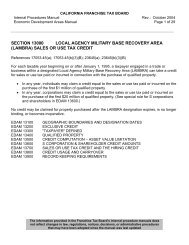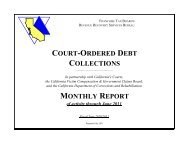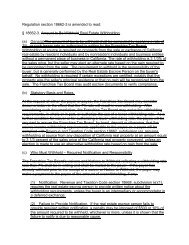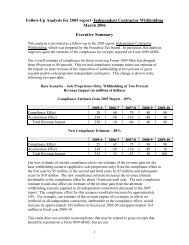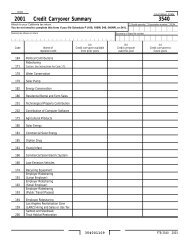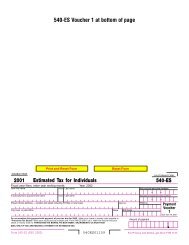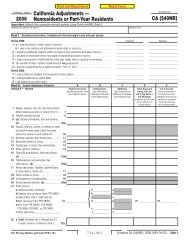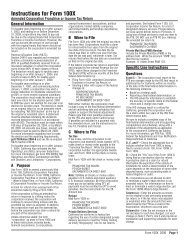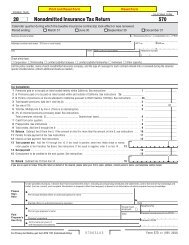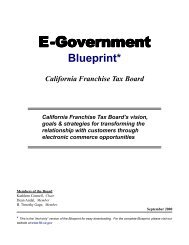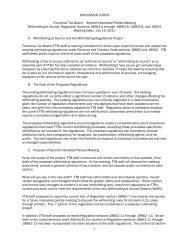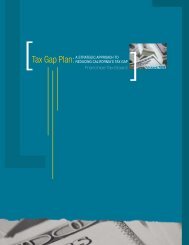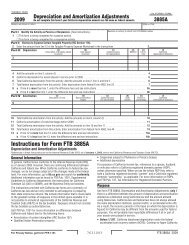Frequently Asked Questions, Tax Year 2002 and Later - California ...
Frequently Asked Questions, Tax Year 2002 and Later - California ...
Frequently Asked Questions, Tax Year 2002 and Later - California ...
Create successful ePaper yourself
Turn your PDF publications into a flip-book with our unique Google optimized e-Paper software.
Notice of Proposed Assessment (Nonresident or Part-<strong>Year</strong> Resident)<br />
<strong>Frequently</strong> <strong>Asked</strong> <strong>Questions</strong><br />
<strong>Tax</strong> <strong>Year</strong> <strong>2002</strong> <strong>and</strong> <strong>Later</strong><br />
<strong>California</strong> Franchise <strong>Tax</strong> Board
I filed a nonresident return, why are you sending me this notice?<br />
You did not include the correct amount of income in your adjusted gross income from all sources on Form 540NR, <strong>California</strong><br />
Nonresident or Part-<strong>Year</strong> Resident Income <strong>Tax</strong> Return. This notice adds back the income you excluded so that we can tax<br />
your <strong>California</strong> income at the correct rate.<br />
I filed a resident return, why are you sending me this notice?<br />
The enclosed notice points out the specific error on your tax return. An example of that would be if you underreported your<br />
federal adjusted gross income by excluding your non-<strong>California</strong> sourced income or you incorrectly subtracted income as a<br />
<strong>California</strong> income adjustment.<br />
It appears you made this error because you were not a <strong>California</strong> resident all year <strong>and</strong> tried to exclude non-<strong>California</strong> sourced<br />
income. The enclosed notice makes two adjustments:<br />
1. It adds back the excluded income.<br />
2. It revises your resident return to reflect the correct tax for a nonresident or part-year resident return.<br />
Why did you use non-<strong>California</strong> sourced income to figure my <strong>California</strong> tax rate?<br />
<strong>California</strong> law provides the specific method to determine the tax liability of nonresidents or part-year residents. We use your<br />
total income to compute the rate at which to tax your <strong>California</strong> income. We:<br />
1. Determine your total taxable income <strong>and</strong> tax as if you were a <strong>California</strong> resident all year.<br />
2. Calculate the tax rate by dividing the ‘<strong>Tax</strong> on your Total <strong>Tax</strong>able Income’ by the ‘Total <strong>Tax</strong>able Income’ itself.<br />
3. Multiply only your <strong>California</strong> taxable income by this rate.<br />
References: <strong>California</strong> Revenue <strong>and</strong> <strong>Tax</strong>ation Code Section 17041, subdivisions (b) <strong>and</strong> (d) <strong>and</strong> Appeal of Dennis L. Boone, 93-SBE-015,<br />
October 28, 1993.<br />
What are the steps for calculating the tax of nonresidents or part-year residents applying the <strong>California</strong> method?<br />
The following example demonstrates the <strong>California</strong> method of calculating tax for nonresidents or part-year residents.<br />
Sally moved to <strong>California</strong> from New York on September 1, <strong>2002</strong>. Her:<br />
Total income <strong>and</strong> expenses from <strong>California</strong> <strong>and</strong> New York were:<br />
• Wages of $30,000.<br />
• $300 in interest on a savings account.<br />
• $3,300 in itemized deductions, including $3,000 in mortgage interest she paid on her New York home.<br />
<strong>California</strong> income included:<br />
• Wages of $10,000 earned after September 1, <strong>2002</strong>.<br />
• $100 in interest earned after September 1, <strong>2002</strong>.<br />
Steps used to compute Sally's <strong>California</strong> tax<br />
Step 1 Sally determines her AGI from all sources as if Wages<br />
$30,000<br />
Adjusted<br />
Gross Income<br />
(AGI) from<br />
All Sources<br />
she was a <strong>California</strong> resident all year. This includes<br />
income both from sources inside <strong>and</strong><br />
outside <strong>California</strong>.<br />
Note: Sally did not exclude her New York<br />
income in this step.<br />
Interest<br />
AGI from all sources<br />
+ 300<br />
$30,300<br />
Step 2 Sally computes her tax on her total taxable income AGI from all sources $30,300<br />
<strong>Tax</strong> on Total<br />
<strong>Tax</strong>able<br />
Income<br />
as if she was a resident of <strong>California</strong> the entire<br />
year<br />
Note: A <strong>California</strong> resident pays this amount of<br />
Itemized deductions<br />
Total taxable income<br />
-3,300<br />
$27,000<br />
tax. <strong>Tax</strong> on total taxable income $ 949<br />
Step 3 Sally calculates her <strong>California</strong> tax rate by dividing <strong>Tax</strong> on total taxable income $949<br />
<strong>California</strong> <strong>Tax</strong><br />
Rate<br />
the tax computed on the total taxable income by<br />
the total taxable income.<br />
Note: This is the same tax rate we charge a<br />
<strong>California</strong> resident.<br />
Total taxable income<br />
<strong>California</strong> tax rate<br />
$27,000<br />
.0351<br />
Step 4 Sally's <strong>California</strong> AGI only includes income from Wages $10,000<br />
<strong>California</strong><br />
sources inside <strong>California</strong>. Interest + 100<br />
Adjusted Note: While a <strong>California</strong> resident, Sally did not<br />
Gross Income earn or receive income from non-<strong>California</strong><br />
(AGI) sources.<br />
<strong>California</strong> AGI $10,100
Step 5<br />
<strong>California</strong><br />
Prorated<br />
Itemized or<br />
St<strong>and</strong>ard<br />
Deductions<br />
Step 6<br />
<strong>California</strong><br />
<strong>Tax</strong>able<br />
Income<br />
Sally's <strong>California</strong> prorated itemized<br />
deductions are the total deductions<br />
allowed a <strong>California</strong> resident multiplied<br />
by a ratio - <strong>California</strong> AGI divided by the<br />
AGI from all sources. This same<br />
proration formula is used if Sally claims<br />
the st<strong>and</strong>ard deduction.<br />
Note: Since Sally pays only a portion<br />
of the tax a <strong>California</strong> resident pays,<br />
her deductions are also prorated.<br />
Sally's <strong>California</strong> taxable income is her<br />
<strong>California</strong> AGI minus her <strong>California</strong><br />
prorated itemized deductions.<br />
Itemized deductions x <strong>California</strong> AGI = CA Prorated ID<br />
AGI from all sources<br />
$ 3,300 x $10,100 = $1,100<br />
$30,300<br />
<strong>California</strong> prorated $1,100<br />
itemized deductions<br />
<strong>California</strong> AGI $10,100<br />
<strong>California</strong> prorated deductions -1,100<br />
<strong>California</strong> taxable income $ 9,000<br />
Step 7 Sally multiplies her <strong>California</strong> taxable <strong>California</strong> taxable income $ 9,000<br />
<strong>California</strong> <strong>Tax</strong><br />
Before Credits<br />
Step 8<br />
<strong>California</strong><br />
Prorated<br />
Exemption<br />
Credits<br />
Step 9<br />
<strong>California</strong> <strong>Tax</strong><br />
income (Step 6) by the <strong>California</strong> tax<br />
rate (Step 3). <strong>California</strong> tax rate x .0351<br />
Sally multiplies her exemption credits by<br />
a ratio – <strong>California</strong> taxable income<br />
divided by the total taxable income.<br />
Note: Since Sally pays only a portion<br />
of the tax a <strong>California</strong> resident pays,<br />
her exemption credits are also<br />
prorated.<br />
Sally computes her <strong>California</strong> tax after<br />
credits by subtracting her prorated<br />
exemption credits from her tax before<br />
credits.<br />
<strong>California</strong> tax before credits $315.90<br />
Exemption x <strong>California</strong> taxable income = CA Prorated Credits<br />
Total taxable income<br />
$80 x $9,000 = $27<br />
$27,000<br />
<strong>California</strong> prorated = $27<br />
exemption credits<br />
<strong>California</strong> tax before credits $316<br />
Prorated exemption credits -27<br />
<strong>California</strong> tax $289<br />
Is <strong>California</strong> taxing my non-<strong>California</strong> sourced income?<br />
No. We are not taxing your non-<strong>California</strong> sourced income. Your non-<strong>California</strong> sourced income is used only to determine the<br />
rate of tax <strong>and</strong> the ratios used to compute your <strong>California</strong> tax liability. The <strong>California</strong> State Board of Equalization has consistently<br />
held that the <strong>California</strong> method of computing your nonresident tax liability is not taxing your non-<strong>California</strong> sourced income.<br />
References: Appeals of Louis N. Million, 87-SBE-036, May 7, 1987, <strong>and</strong> Dennis L. Boone, 93-SBE-015, October 28, 1993.<br />
Does it violate the U.S. Constitution for <strong>California</strong> to use income from outside <strong>California</strong> to determine my <strong>California</strong> tax<br />
liability?<br />
No. It has long been established that states may use nontaxable out-of-state assets to calculate the state's tax liability. Therefore,<br />
we include income from outside the state to calculate your <strong>California</strong> income tax liability.<br />
Reference: See Maxwell v. Bugbee (1919) 250 U.S. 525 [63 L. Ed. 1124]<br />
When I use the <strong>California</strong> method, I owe more tax than if I did not include the non-<strong>California</strong> income. Is this appropriate?<br />
Yes. <strong>California</strong> bases its progressive rate structure on the "ability to pay" concept. Individuals with higher income pay tax at a<br />
higher rate than low-income individuals. The courts have reasoned that similarly situated taxpayers are those with the same total<br />
income.<br />
For example, a nonresident earning $20,000 in <strong>California</strong>, but with repor ted total income of $100,000, is taxed at the same rate<br />
as a resident with an income of $100,000. In effect, the $20,000 is taxed at the same tax rate as a <strong>California</strong> resident. Not using<br />
your total income to determine your tax rate would unfairly benefit you when compared with other taxpayers.<br />
References: Brady v. New York (1992) 80 N.Y.2d 596, 605 [607 N.E.2d 1060], certiorari denied (1993) 509 U.S. 905 [125 L.Ed.2d 692; 113 S.<br />
Ct. 2998]
Can I change my filing status to married filing separately after I filed a joint return?<br />
Generally, no. You cannot elect to change your filing status to married filing separately after the due date of the tax return,<br />
unless either you or your spouse was:<br />
• An active member of the armed forces or any auxiliary branch, or<br />
• A nonresident for the entire taxable year with no <strong>California</strong> sourced income.<br />
Note: If the spouse that earned <strong>California</strong> sourced income is domiciled in a community property state, you do not meet<br />
the exception above. You must split the <strong>California</strong> sourced income equally between the spouses, which means both of<br />
you have <strong>California</strong> sourced income.<br />
If you meet either of the above exceptions, you must file a Form 540X (Amended Individual Income <strong>Tax</strong> Return) to change<br />
your filing status to married filing separately within four years of the due date of the tax return.<br />
References: <strong>California</strong> Revenue <strong>and</strong> <strong>Tax</strong>ation Code Sections 18415 (a), 18521, 18566 <strong>and</strong> 19006 (b); Appeal of Bennie A. Jefferson,<br />
79-SBE-104, June 28, 1979.<br />
Another state also taxed the additional income on my notice. Do I have to pay taxes to both states?<br />
It depends. <strong>California</strong> allows certain taxpayers a credit against <strong>California</strong> tax for net income taxes imposed by <strong>and</strong> paid to<br />
another state when the income is also taxed by <strong>California</strong>. To qualify as double taxed income, the income must be included in<br />
your <strong>California</strong> adjusted gross income. If the income is only in the adjusted gross income from all sources <strong>and</strong> not in your<br />
<strong>California</strong> adjusted gross income, it is not taxed by <strong>California</strong>. See Schedule S (Other State <strong>Tax</strong> Credit) to determine if you<br />
qualify for this credit. If you qualify for the credit, send us a completed Schedule S <strong>and</strong> a copy of the other state tax return with<br />
your correspondence.<br />
For information on how to obtain a Schedule S (Other State <strong>Tax</strong> Credit), see “Where To Get Income <strong>Tax</strong> Forms” below.<br />
Does my withholding credit pay the additional tax due?<br />
No. We allowed this credit when we processed your tax return. If you had any excess credit, it was refunded to you. Any credit<br />
amount we did not refund to you is included in the “original or revised tax” figure on the enclosed notice.<br />
If you have additional withholding credit that was not claimed or allowed on your return, send us a copy of the Wage <strong>and</strong> <strong>Tax</strong><br />
Statement, Form W2 that shows the additional <strong>California</strong> state withholding credit with your correspondence.<br />
Telephone Assistance<br />
From within the United States, call (800) 852-5711<br />
From outside the United States, call (not toll-free) (916) 845-6500<br />
Website at: www.ftb.ca.gov<br />
Assistance for persons with disabilities: We comply with the Americans with Disabilities Act. Persons with hearing or<br />
speech impairments please call TTY/TDD (800) 822-6268.<br />
Where To Get Income <strong>Tax</strong> Forms<br />
Internet <strong>California</strong> income tax forms <strong>and</strong> publications are now available on the Franchise <strong>Tax</strong> Board Website at:<br />
www.ftb.ca.gov<br />
Telephone Call our toll-free number shown under Telephone Assistance above.<br />
Mail Write to: TAX FORMS REQUEST UNIT<br />
FRANCHISE TAX BOARD<br />
PO BOX 307<br />
RANCHO CORDOVA CA 95741-0307<br />
FTB Pub. 1044A (REV 12-2004)



